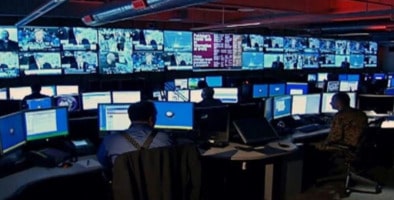Fusion centers are notoriously secretive about public surveillance and what little we know can be summed up thusly:
“official secrecy, moreover, cloaks fusion centers, so what little public information is available on a particular fusion center rarely provides much detail on its unique profile.”
The MIAC Shadow Report reveals how law enforcement goes out of their way to hide who’s actually in charge of public surveillance, and it is pre-occupied with people committing conventional crimes.
The report begins by revealing what many of us already knew or suspected: fusion centers have been and continue to surveil protesters and activists.
“Fusion centers are the nerve system of mass criminalization” the report warns. A major concern of the authors is how fusion centers use private corporations to conduct secret facial recognition and social media surveillance of “people of interest” and warns that self-governing fusion centers are fraught with peril.
Despite there being a statewide ban of using facial recognition to ID innocent people in Maine there is evidence MIAC uses data brokers to do an end-run around privacy bans.
“This legislation bans the use of the technology in most areas of government and strictly limits its use by law enforcement.9 In our review of BlueLeaks documents, we found documents that raise questions about the MIAC’s use of private data brokers and ability to analyze cell phone data. These systems, like the recently regulated facial recognition technology, also pose existential threats to privacy and other basic rights.”
The report also found that fusion centers are being used to surveil the homeless, including people with mental illnesses and substance abuse.
It appears that the majority of what fusion centers do is ID “suspicious people, people of interest, suspects, missing persons, and wanted people.”
“The majority of MIAC documents concern the sharing of criminal information. Two-thirds of the BlueLeaks documents definitely shared by the MIAC—939 of 1,382—are (1) requests to identify a suspect or a wanted person, locate a person of interest or missing person, or provide information about possible crimes or suspicious circumstances or (2) bulletins and reports on specific incidents, cases, or individuals considered relevant to law enforcement but not directly connected to a criminal investigation by a police agency in Maine.”
Supermarkets, gas stations, utility companies, universities and hospitals receive daily “civil unrest” bulletins
The report reveals that fusion centers send daily intelligence (civil unrest) reports to 4,526 registered users in Maine. The reports focus on protests and political violence, lumping together subjects like “civil unrest,” “extremism,” and “terrorism.”
“This expansive list includes law enforcement officers and intelligence officials from across Maine, the New England Region, and across the country. It extends beyond law enforcement and intelligence to other government officials such as Department of Motor Vehicles personnel and school superintendents. The MIAC’s reach extends outside of the public sector. Many large corporations receive MIAC products, including Avangrid, Hannaford’s, ExxonMobile, and Bath Iron Works. Civil society organizations and nonprofits are also involved, such as universities, hospitals, and even special interest groups. The president of the Maine Chamber of Commerce, for example, is a registered user of the MIAC but, in contrast, there are no representatives from organized labor listed.”
The report also revealed that fusion centers are monitoring people who commit property crimes or shoplifting and sends daily reports to businesses.
“Private firms also access documents. The most prolific private sector reader of MIAC reports is the Auburn Mall. Auburn, along with neighboring Lewiston, are the twin cities of Maine. They are post-industrial mill towns, which have not yet been gentrified. They contain the four highest poverty census tracts in the state. The opioid epidemic has devastated this region. Mall security at the Auburn Mall mostly reads documents on persons who have been arrested for opioid use and shoplifting.”
The Maine Beacon warns that “counterterrorism has morphed into supercharged policing of drug, and property crimes,” and says “This is public-private surveillance.”
How easy is it for police officers to use fusion centers to secretly collect information on an innocent person?
MIAC, like fusion centers everywhere “can acquire and retain information that is unrelated to a specific criminal or public safety threat, as long as it determines that such information is useful.” As the report states, “the policy provides no definitions or standards for determining when information is useful in the administration of public safety.”
Let that sink in for a moment; fusion centers can basically spy on anyone, even if they are not a “public safety threat” as long as a police officer determines that the information they collect on a person is useful!
The report also revealed that fusion centers are “acquiring, retaining and sharing information about individuals and organizations based solely on their religious, political, or social views or activities.”
Fusion centers commonly send “situational awareness bulletins” to police departments about a person’s mental illness, saying these types of disclosures are common.
Full article: Fusion Centers Target The Homeless, Substance Abusers, Protesters And More
